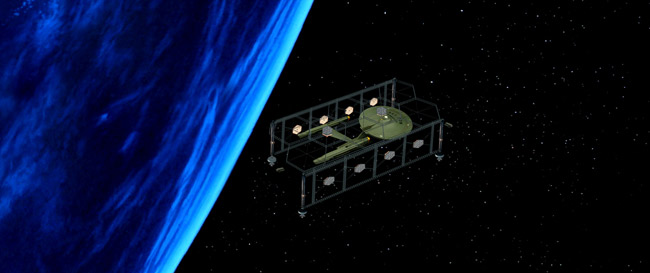-
Welcome! The TrekBBS is the number one place to chat about Star Trek with like-minded fans.
If you are not already a member then please register an account and join in the discussion!
You are using an out of date browser. It may not display this or other websites correctly.
You should upgrade or use an alternative browser.
You should upgrade or use an alternative browser.
ST:TMP: Was such a massive refit of the USS Enterprise logical?
- Thread starter Tribble puncher
- Start date
The older trek RPG ship recognition manuals, and Mr. Scott's Guide to the Enterprise, also support a gradual upgrade. Hey, we've got new nacelles. Oh, the old pylons won't support them that well? Swap 'em. Ahh, we'll have to rebuild engineering too, AND all its adjacent areas, to support that fancy schmancy new warp core. It extends all the way up the impulse deck, so that's gotta go too.. Oh, we've upgraded the computers and will be getting newer torpedo launchers, so keep rebuilding the saucer and neck. And... we've run out of paint. We didn't really NEED it anyway, so leave it. Good? Good.
Computer simulations, and simple math, should have told them what would and wouldn't work. Before they knocked down the first wall.
Likely it was before they knocked out even one bulkhead, but it would be a process to get to the end redesign. It is also possible that they started out with just a nacelle and pylon replacement where the computers said it should work within tolerances...except Enterprise wasn't within those tolerances due to other changes, and they found out later in field testing that with the way the ship was, the engines wouldn't be as effective as they could be, resulting in her coming back for more upgrading. The second time would be more comprehensive and last 18 months.
Christopher's DTI novels supply an ulterior motive for the refit, based on the unique properties the TOS nacelles had acquired by chance.
Perhaps @Christopher wouldn't mind adding to this topic, but this was indeed part of the reason. I also seem to recal from either Forgotten History or Ex Machina, that another reason for the complicated and complex refit instead of building a new ship, was PR and damage control. Kirk f***ed something up, and needed to be punished. However, guy is also one big damned hero to the public. So, they promote Kirk to get him out of the field and behind a desk, and as a reward and PR stunt, the Enterprise is chosen as the first ship to be upgraded to the new level of technology that was available.
I could be wrong though.
I don't so? at least I don't recall that the last time I re-read it.
The idea was cost effectiveness, the original Constitution class framework could be built around slightly faster and result in a Refit design in less time than scratch building the entire spaceframe, and using new resources tto build the hull rather than recycling the old.
It gave them nearly twice as many refit hulls for less time and effort. Given how long the Enterprise stayed in service and well she held up, I don't think it impacted their performance either. If anything, the Enterprise A shows scratch builds weren't as tough.
The idea was cost effectiveness, the original Constitution class framework could be built around slightly faster and result in a Refit design in less time than scratch building the entire spaceframe, and using new resources tto build the hull rather than recycling the old.
It gave them nearly twice as many refit hulls for less time and effort. Given how long the Enterprise stayed in service and well she held up, I don't think it impacted their performance either. If anything, the Enterprise A shows scratch builds weren't as tough.
It may (or may not) be helpful to understand the "why"s of how we ended up with the refit design.
First of all, was there a definitive TOS Enterprise design to start with? Looking at the production history, this is what was used...
So there were a lot of versions which differ from each other in various degrees. And even if one subscribes to the 11 foot model being the definitive TOS Enterprise design, in the 1970s no one had accurate plans of it. For most fans back then, we worked with the Franz Joseph plans.
Moving forward to 1977 and preproduction of the Star Trek II television series (known as Phase II since the release of the second movie), and Roddenberry wanted an updated version of the Enterprise. Jefferies has ideas of what an upgrade might be like (mainly replacing the engines) but because he was working on Little House on the Prairie, he handed these ideas over to Minor to complete.
Again, because the Franz Joseph plans were very popular back then, Minor used them as a starting point and came up with this...
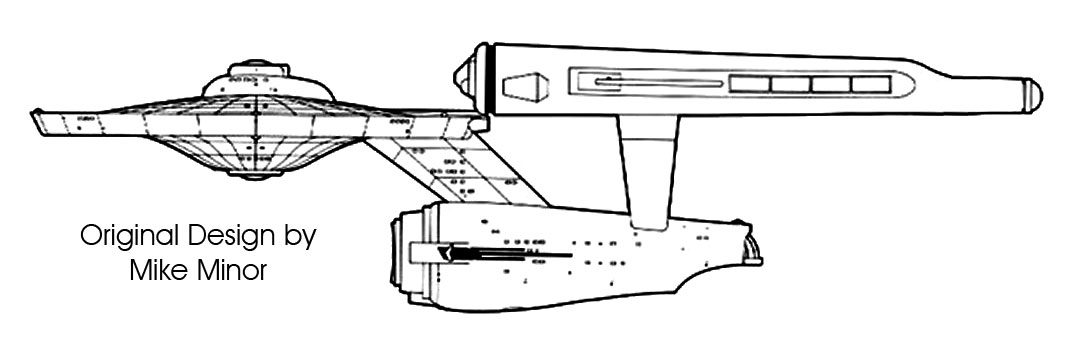
... which Roddenberry wasn't happy with and asked that Jefferies take a more hands on approach. And from Jefferies' point of view, fans didn't seem all that discriminating over differences in geometry of things like the primary and secondary hulls. He believed that he could make alterations to them as long as they still felt familiar to what the fans had seen on screen in TOS. He drew up plans for the Phase II Enterprise, but omitted many of the details which were to be taken from the 33 inch Enterprise model (which was in Roddenberry's office at this point).
These are some shots of Price and Loos working on the Phase II Enterprise...
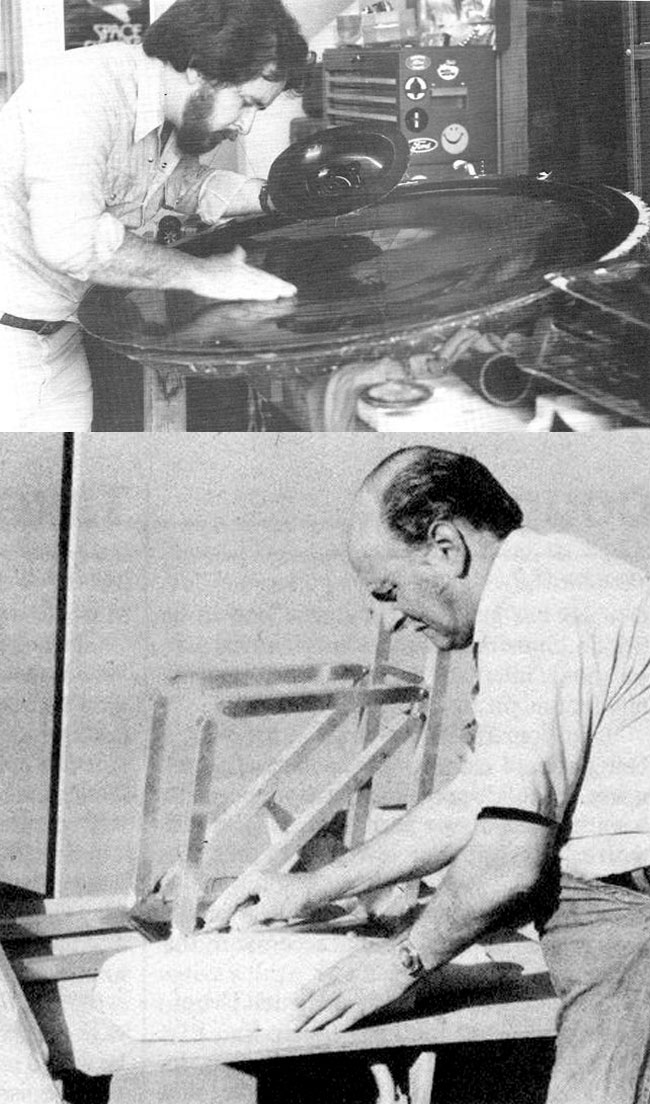
and some test assembly shots of the model...

With the beginning of 1978, the series turned into a feature film and Robert Abel and Associates is brought on to do the effects. Taylor heads the team from Robert Abel and Associates and convinces Roddenberry that a new larger model of the Enterprise is needed that would have more detailing for the large screen. Taylor wants to redesign the Enterprise, but Roddenberry likes Jefferies' overall design for the Phase II Enterprise and has Taylor's team use that as a starting point.
Taylor would have people believe that he (and Probert) took the design of the Franz Joseph plans as a starting point to design their plans used by Magicam to build the TMP studio model...
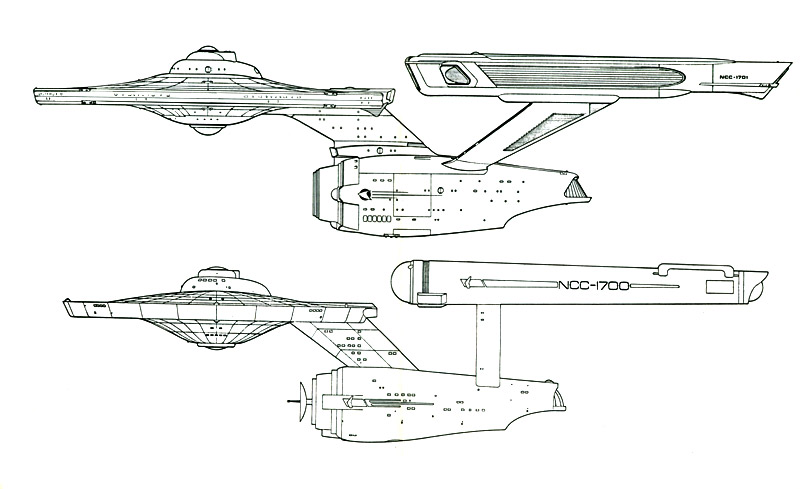
That is actually quite disingenuous, this is a better comparison of where they started from to where they ended up...
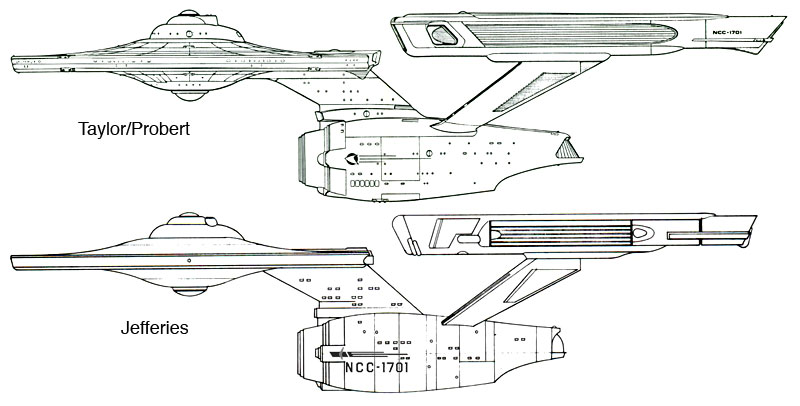
But what that basically means is that they were working from Jefferies' plans as a starting point which were intended to have been a pretty reasonable upgrade to the systems/engines of the original Enterprise. And even though there was a lot of changes made to the geometry of the primary and secondary hulls, the final ship was intended to seem like the original Enterprise on screen.
When all those intended TOS elements were removed from the design by Taylor/Probert, it looks like a more drastic change. Comparing the Phase II Enterprise with the TMP Enterprise, one can see how the two are related...
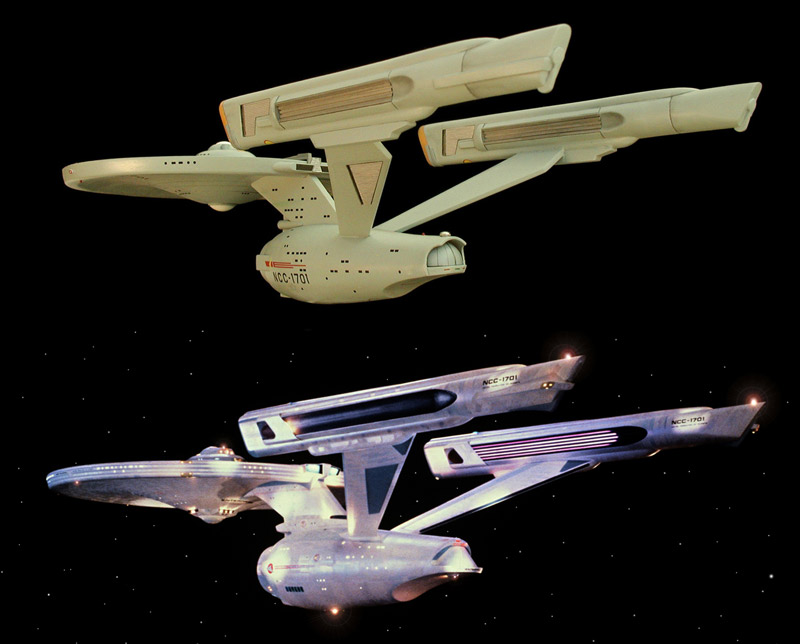
Would it have been nice to have started with the 11 foot Enterprise design? Sure... but they couldn't. In the late 1970s and 1980s the best plans of the 11 foot model were the ones by Allen Everheart. The first reasonably accurate plans didn't show up until the mid 1990s (drawn by Kerr and used by Jein to build the DS9 Enterprise model).
The intent was for the Enterprise to be the Enterprise... even if the artist lacked the ability to do it.
Here is a bit more detailed history of the Phase II Enterprise...
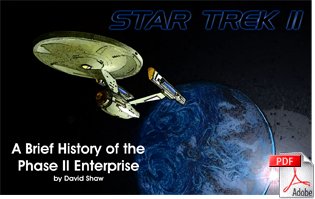
click to download (PDF, 1.8 MB)
I don't know if any of that is helpful or not, but I figured I'd share it with you guys.
Now, had we been reintroduced to the Enterprise in space dock like this...
... I don't think people would have questioned if it was the same ship as seen in TOS.
First of all, was there a definitive TOS Enterprise design to start with? Looking at the production history, this is what was used...
- October 1964, original drafted plans for studio models
- November 1964, final drafted plans for studio models
- November 1964, 33 inch studio model
- December 1964, 11 foot studio model
- Spring 1966, Jefferies provides plans for AMT's model kit (used on screen in the second season of TOS)
- 1966/1967, Jefferies writers' guide illustrations
- April 1967, 3 inch Enterprise Working Props (used on screen in the second season of TOS)
- November 1964, final drafted plans for studio models
- November 1964, 33 inch studio model
- December 1964, 11 foot studio model
- Spring 1966, Jefferies provides plans for AMT's model kit (used on screen in the second season of TOS)
- 1966/1967, Jefferies writers' guide illustrations
- April 1967, 3 inch Enterprise Working Props (used on screen in the second season of TOS)
So there were a lot of versions which differ from each other in various degrees. And even if one subscribes to the 11 foot model being the definitive TOS Enterprise design, in the 1970s no one had accurate plans of it. For most fans back then, we worked with the Franz Joseph plans.
Moving forward to 1977 and preproduction of the Star Trek II television series (known as Phase II since the release of the second movie), and Roddenberry wanted an updated version of the Enterprise. Jefferies has ideas of what an upgrade might be like (mainly replacing the engines) but because he was working on Little House on the Prairie, he handed these ideas over to Minor to complete.
Again, because the Franz Joseph plans were very popular back then, Minor used them as a starting point and came up with this...

... which Roddenberry wasn't happy with and asked that Jefferies take a more hands on approach. And from Jefferies' point of view, fans didn't seem all that discriminating over differences in geometry of things like the primary and secondary hulls. He believed that he could make alterations to them as long as they still felt familiar to what the fans had seen on screen in TOS. He drew up plans for the Phase II Enterprise, but omitted many of the details which were to be taken from the 33 inch Enterprise model (which was in Roddenberry's office at this point).
These are some shots of Price and Loos working on the Phase II Enterprise...

and some test assembly shots of the model...

With the beginning of 1978, the series turned into a feature film and Robert Abel and Associates is brought on to do the effects. Taylor heads the team from Robert Abel and Associates and convinces Roddenberry that a new larger model of the Enterprise is needed that would have more detailing for the large screen. Taylor wants to redesign the Enterprise, but Roddenberry likes Jefferies' overall design for the Phase II Enterprise and has Taylor's team use that as a starting point.
Taylor would have people believe that he (and Probert) took the design of the Franz Joseph plans as a starting point to design their plans used by Magicam to build the TMP studio model...

That is actually quite disingenuous, this is a better comparison of where they started from to where they ended up...

But what that basically means is that they were working from Jefferies' plans as a starting point which were intended to have been a pretty reasonable upgrade to the systems/engines of the original Enterprise. And even though there was a lot of changes made to the geometry of the primary and secondary hulls, the final ship was intended to seem like the original Enterprise on screen.
When all those intended TOS elements were removed from the design by Taylor/Probert, it looks like a more drastic change. Comparing the Phase II Enterprise with the TMP Enterprise, one can see how the two are related...

Would it have been nice to have started with the 11 foot Enterprise design? Sure... but they couldn't. In the late 1970s and 1980s the best plans of the 11 foot model were the ones by Allen Everheart. The first reasonably accurate plans didn't show up until the mid 1990s (drawn by Kerr and used by Jein to build the DS9 Enterprise model).
The intent was for the Enterprise to be the Enterprise... even if the artist lacked the ability to do it.
Here is a bit more detailed history of the Phase II Enterprise...

click to download (PDF, 1.8 MB)
I don't know if any of that is helpful or not, but I figured I'd share it with you guys.
Now, had we been reintroduced to the Enterprise in space dock like this...
... I don't think people would have questioned if it was the same ship as seen in TOS.
Exactly. And Shaw didn't imply otherwise when he wrote (emphasis mine): "Taylor would have people believe that he (and Probert) took the design of the Franz Joseph plans as a starting point to design their plans used by Magicam to build the TMP studio model..."I don't remember Mr. Probert ever insinuating that the design he helped finalize came straight from the TV version. He's mentioned in several places that he was brought in to work out the kinks in the Phase II version, itself an evolution of the TV version.
Last edited:
I'd like to refute one tiny bit of Shaw's excellent overview of the Phase II Enterprise's evolution to the motion picture design. The initial design shown labeled "Original Design by Mike Minor" with the odd nacelles was derived from this sketch that initially appeared in an early Starlog magazine interview with Gene Roddenberry about the aborted Planet Of The Titans. When the interview was published, news had surfaced that Phase II was now in production. The interview had a number of Mike Minor illustrations, including this image of the Enterprise showing some of the proposed changes (the image reproduced in Starlog didn't look nearly this good BTW):

I'm quite convinced that this image was misinterpreted by many people because the angle makes it look like the pylons are at a right angle to the secondary hull rather than swept back like the changes proposed by Matt Jeffries. I believe the engines are in fact the same Phase II engines we've seen in other Mike Minor artwork (see below) as well as the photos of the Phase II series model. When I first saw the original Mike Minor image, I tried to work out the engine shapes and came up with something similar like the first illustration in Shaw's response labeled "Original Design by Mike Minor". Eventually a more refined illustration became available which more clearly showed the shape of the engines though in truth without a plan view, the nacelle shapes were still open to interpretation:

I really believe that these two Mike Minor illustrations show the same nacelle design but again, without a clear plan view the details were left to interpretation.
Finally, it seems clear based on these two illustrations that the original intent was to show that the primary and secondary hulls were essentially the same as the TV version even though the markings were modified a bit. The only upgrades were to the struts, nacelles, deflector dish (it looks like pushed back a bit though that's not entirely conclusive) and finally the addition of the Photon Torpedo launchers.

I'm quite convinced that this image was misinterpreted by many people because the angle makes it look like the pylons are at a right angle to the secondary hull rather than swept back like the changes proposed by Matt Jeffries. I believe the engines are in fact the same Phase II engines we've seen in other Mike Minor artwork (see below) as well as the photos of the Phase II series model. When I first saw the original Mike Minor image, I tried to work out the engine shapes and came up with something similar like the first illustration in Shaw's response labeled "Original Design by Mike Minor". Eventually a more refined illustration became available which more clearly showed the shape of the engines though in truth without a plan view, the nacelle shapes were still open to interpretation:

I really believe that these two Mike Minor illustrations show the same nacelle design but again, without a clear plan view the details were left to interpretation.
Finally, it seems clear based on these two illustrations that the original intent was to show that the primary and secondary hulls were essentially the same as the TV version even though the markings were modified a bit. The only upgrades were to the struts, nacelles, deflector dish (it looks like pushed back a bit though that's not entirely conclusive) and finally the addition of the Photon Torpedo launchers.
Last edited:
Regarding the nacelles and pylons. If the old pylons weren't strong enough, what weren't they strong enough for?
There's no gravity and I don't think the nacelles provide thrust per se. Even if either of those things were the case, the new pylons didn't look much thicker, just swept back.
Wasn't it in Mr. Scott's Guide that it said the new pylon design increased efficiency?
Aesthetically, a shiny, cleaned up version of the Phase II design would've been just a beautiful as the TMP version.
There's no gravity and I don't think the nacelles provide thrust per se. Even if either of those things were the case, the new pylons didn't look much thicker, just swept back.
Wasn't it in Mr. Scott's Guide that it said the new pylon design increased efficiency?
Aesthetically, a shiny, cleaned up version of the Phase II design would've been just a beautiful as the TMP version.
Perhaps the design of the new engines demanded a connection point near the middle of the nacelle, rather than forward. After all, the Old engines seemed to be largely self contained, so the connection point may not have been that important, but the new engines have the reactor in the hull and are fed from there.
So perhaps the angled nacelles are simply the result of design requirements.
--Alex
So perhaps the angled nacelles are simply the result of design requirements.
--Alex
And that's the other pertinent question. Did the TMP refit actually spearhead anything? Or was Kirk's ship simply seriously behind the technology curve (and the haute couture in general) because of having been stranded in the far frontier for five years?
If the Enterprise was just catching up then it wouldn't have been so hard to find crew that were rated on the new equipment. The (IMHO) obvious intent was that this was an astonishing leap forward.
Of course this brings up a somewhat contradictory notion about the TOS Enterprise. The writer's guide says she's an "old" ship. She's supposed to be on the very farthest edge of the frontier. But she's also supposed to be cutting edge and all that.
Considering how Kirk or Scott talk about the ship, I get the feeling she's still old under all that new tech and some fresh bulkheads. And in TOS, how the Klingons talk about her would seem to how she is an old ship. Add to this the knowledge that Spock served on USS Enterprise over a decade before Kirk too command (Since before "The Cage").
That labeled image of the Minor painting is my handiwork back when there was some discussion about what the design intent was, before Shaw shared some of his research materials.I'd like to refute one tiny bit of Shaw's excellent overview of the Phase II Enterprise's evolution to the motion picture design. The initial design shown labeled "Original Design by Mike Minor" with the odd nacelles was derived from this sketch that initially appeared in an early Starlog magazine interview with Gene Roddenberry about the aborted Planet Of The Titans. When the interview was published, news had surfaced that Phase II was now in production. The interview had a number of Mike Minor illustrations, including this image of the Enterprise showing some of the proposed changes (the image reproduced in Starlog didn't look nearly this good BTW):

I'm quite convinced that this image was misinterpreted by many people because the angle makes it look like the pylons are at a right angle to the secondary hull rather than swept back like the changes proposed by Matt Jeffries. I believe the engines are in fact the same Phase II engines we've seen in other Mike Minor artwork (see below) as well as the photos of the Phase II series model. When I first saw the original Mike Minor image, I tried to work out the engine shapes and came up with something similar like the first illustration in Shaw's response labeled "Original Design by Mike Minor". Eventually a more refined illustration became available which more clearly showed the shape of the engines though in truth without a plan view, the nacelle shapes were still open to interpretation:

I really believe that these two Mike Minor illustrations show the same nacelle design but again, without a clear plan view the details were left to interpretation.
Finally, it seems clear based on these two illustrations that the original intent was to show that the primary and secondary hulls were essentially the same as the TV version even though the markings were modified a bit. The only upgrades were to the struts, nacelles, deflector dish (it looks like pushed back a bit though that's not entirely conclusive) and finally the addition of the Photon Torpedo launchers.
I can't speak to what Minor intended prior to the Enterprise redesign being handed back to Jefferies, certainly not based on what little of his work re the ship exterior I've seen.
Last edited:
I found this great example of massive refits in an Osprey book, "WWI Seaplane and Aircraft carriers."
This is HMS Furious, originally planned as a "large light cruiser." Shortly before completion in 1917, it was decided to nix the forward gun turret and install a fly-off deck. After trials, they decided a landing deck would be a good idea too, and the aft gun was removed, making her no longer capable of her initial design purpose. The superstructure and stack were in the middle of the deck, requiring planes to be towed around them on narrow connecting bridges to get forward. By 1922, the full-deck flattop motif was applied, with the superstructure demolished and the stack rerouted.
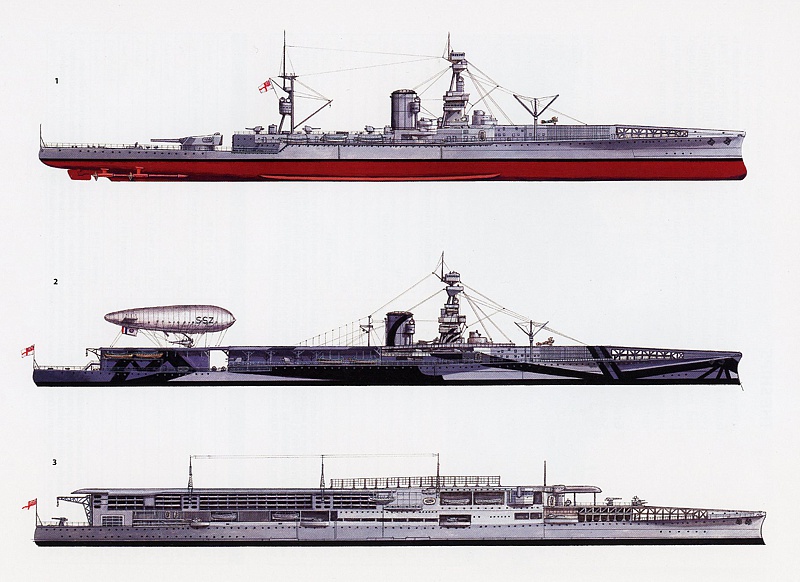
Artwork ©Paul Wright for Osprey Publishing.
This is HMS Furious, originally planned as a "large light cruiser." Shortly before completion in 1917, it was decided to nix the forward gun turret and install a fly-off deck. After trials, they decided a landing deck would be a good idea too, and the aft gun was removed, making her no longer capable of her initial design purpose. The superstructure and stack were in the middle of the deck, requiring planes to be towed around them on narrow connecting bridges to get forward. By 1922, the full-deck flattop motif was applied, with the superstructure demolished and the stack rerouted.

Artwork ©Paul Wright for Osprey Publishing.
I don't feel there's a reasonable way to construct an in-universe explanation. The fact of the matter is the design was driven by the behind-the-scenes desire to make the ship look more contemporary which created a clash against the "refit" theme of the script. It was a tradeoff but considering that the ship was sufficiently cutting edge to function across six movies, I'd say it was the right call. The original Phase II enterprise carried over too many 1960s-isms and what was updated incorporated some of the worst early to mid 70s design ideas that would have been perceived as instantly dated by the time the film came out at the end of 1979. The refit is sort of a blend of timeless art-deco with the folded-paper look of cars in the late 70s and 80s, with a greater emphasis on the former.
Perfectly so. Compare pictures of World War 1 battleships to pictures of them towards the end of World War 2 (at least the ones that survived). While they're still the same ship, they look dramatically different.
Ronald Held is right. They did that then and they probably did this in TMP because it was cheaper than building a new ship from scratch. Battleships and battlecruisers are hella expensive, and the TOS Enterprise was that era's Federation battlecruiser more or less.
Ronald Held is right. They did that then and they probably did this in TMP because it was cheaper than building a new ship from scratch. Battleships and battlecruisers are hella expensive, and the TOS Enterprise was that era's Federation battlecruiser more or less.
Similar threads
- Replies
- 209
- Views
- 4K
- Replies
- 132
- Views
- 4K
- Replies
- 19
- Views
- 1K
If you are not already a member then please register an account and join in the discussion!

